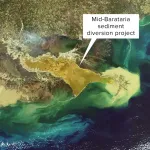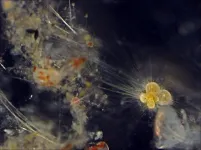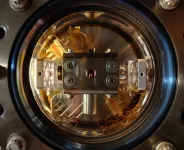(Press-News.org) Boulder, Colo., USA: Article topics and locations include the Red Lake greenstone belt, Canada; Anak Krakatau volcano, Indonesia; martian soil; Glacial Lake Missoula, Montana, USA; and findings from IODP Expedition 385. These Geology articles are online at https://geology.geoscienceworld.org/content/early/recent .
Crustal conductivity footprint of the orogenic gold district in the Red Lake greenstone belt, western Superior craton, Canada
Ademola Q. Adetunji; Gaetan Launay; Ian J. Ferguson; Jack M. Simmons; Chong Ma ...
A magnetotelluric (MT) study across the Red Lake greenstone belt of the western Superior craton, Canada, images a 50-km-long north-dipping conductor (<20 Ω·m) at 20–25 km depth and subvertical conductors spatially correlated with crustal-scale shear zones and large orogenic gold deposits. The conductors are interpreted to be the conductivity signature of the deep crustal source of the auriferous fluids and pathways of the orogenic gold system. The geophysical results, supported by existing geochemical and fluid inclusion studies, suggest that the Au- and CO 2-rich fluids responsible for gold mineralization were released by devolatilization of supracrustal rocks underthrust to mid- to lower-crustal levels during subduction. This MT study links shallow gold mineralization to a deep crustal source region, demonstrating the connection between a crustal suture zone and the formation of orogenic gold deposits in an Archean greenstone belt.
Interactions of magmatic intrusions with the multiyear flank instability at Anak Krakatau volcano, Indonesia: Insights from InSAR and analogue modeling
Edgar U. Zorn; Magdalena Vassileva; Thomas R. Walter; Herlan Darmawan; Leonie Röhler ...
Volcano flank collapses have been documented at ocean islands worldwide and are capable of triggering devastating tsunamis, but little is known about the precursory processes and deformation changes prior to flank failure. This makes the 22 December 2018 flank collapse at Anak Krakatau in Indonesia a key event in geosciences. Here, we provide direct insight into the precursory processes of the final collapse. We analyzed interferometric synthetic aperture radar (InSAR) data from 2014 to 2018 and studied the link between the deformation trend and intrusion occurrence through analogue modeling. We found that the flank was already moving at least 4 yr prior to collapse, consistent with slow décollement slip. Movement rates averaged ~27 cm/yr, but they underwent two accelerations coinciding with distinct intrusion events in January/February 2017 and in June 2018. Analogue models suggest that these accelerations occurred by (re)activation of a décollement fault linked to a short episode of magma intrusion. During intrusion, we observed a change in the internal faults, where the outward-directed décollement accelerated while inward faults became partially blocked. These observations suggest that unstable oceanic flanks do not disintegrate abruptly, but their collapse is preceded by observable deformations that can be accelerated by new intrusions.
Martian soil as revealed by ground-penetrating radar at the Tianwen-1 landing site
Ruonan Chen; Ling Zhang; Yi Xu; Renrui Liu; Roberto Bugiolacchi ...
Much of the Martian surface is covered by a weathering layer (regolith or soil) produced by long-term surface processes such as impact gardening, eolian erosion, water weathering, and glacial modifications. China’s first Martian mission, Tianwen-1, employed the Mars Rover Penetrating Radar (RoPeR) to unveil the detailed structure of the regolith layer and assess its loss tangent. The RoPeR radargram revealed the local regolith layer to be highly heterogeneous and geologically complex and characterized by structures that resemble partial or complete crater walls and near-surface impact lenses at a very shallow depth. However, comparable radar data from the Lunar far side are rather uniform, despite the two surfaces being geologically contemporary. The close-to-surface crater presented in this study shows no detectable surface expression, which suggests an accelerated occultation rate for small craters on the surface of Mars as compared to the rate on the Moon. This is probably due to the relentless eolian processes on the Martian surface that led to the burial of the crater and thus shielded it from further erosion. The high loss tangent indicates that the regolith at the Tianwen-1 landing site is not dominated by water ice.
Rock surface luminescence dating of gravel determines the age of a glacial outburst megaflood, Glacial Lake Missoula, Montana, USA
Larry N. Smith; Reza Sohbati; Mayank Jain
Giant gravel bars are important archives of megafloods; however, determining their depositional ages requires reliable geochronometric methods. Five gravel bars, reaching heights of 150–170 m, formed in the bedrock-lined Alberton Gorge along the Clark Fork River, Montana (USA), during draining of Glacial Lake Missoula (GLM). We report the first numerical ages for megaflood deposits in the GLM basin by successfully applying the novel optically stimulated luminescence (OSL) rock surface dating technique to date cobbles collected from three locations along one bar’s transport direction. Depth-dependent infrared stimulated luminescence and post-infrared pulsed OSL signals showed that exteriors of only 3 out of the 38 collected cobble samples were well bleached by exposure to daylight before burial, and hence suitable for dating. The cobbles provided ages of 16.5 ± 0.9, 18.5 ± 1.4, and 21.7 ± 1.1 ka, all of which are indistinguishable from the average cosmogenic nuclide age of 18.2 ± 1.5 ka (n = 4) for a large megaflood in the Channeled Scabland, eastern Washington State. The average of the two younger ages, 17.5 ± 1.0 ka, is our best estimate of the deposit age. We interpret the older age to be from a cobble that was reworked by the flood. Our results show that these techniques have great potential for providing reliable chronologies for paleofloods and other high-energy depositional events.
Stranding continental crustal fragments during continent breakup: Mantle suture reactivation in the Nain Province of Eastern Canada
Philip J. Heron; A.L. Peace; K.J.W. McCaffrey; A. Sharif; A.J. Yu ...
Earth’s continental crust has evolved through a series of supercontinent cycles, resulting in a patchwork of Archean cores surrounded by terranes, fragments, and slivers of younger crustal additions. However, the dispersal (and/or stranding) of continental fragments during breakup is not well understood. Inherited structures from previous tectonic activity may explain the generation of continental terranes by controlling first-order deformation during rifting. Here, we explored the influence of lithospheric deformation related to ancient orogenesis, focusing on the impact of the Torngat orogen in the genesis of the Nain Province continental fragment in Eastern Canada. We present three-dimensional continental extension models in the presence of an inherited lithospheric structure and show that a narrow continental terrane could be separated and stranded by deep lithospheric scarring. The results show that continental terranes formed by this method would be limited to a width of 100–150 km, imposed by tectonic conditions during continental suturing. The findings have broad implications, demonstrating an original theory on the fundamental geologic problem of terrane generation and continent breakup.
Carbon released by sill intrusion into young sediments measured through scientific drilling
Daniel Lizarralde; Andreas Teske; Tobias W. Höfig; Antonio González-Fernández; IODP Expedition 385 Scientists
The intrusion of igneous sills into organic-rich sediments accompanies the emplacement of igneous provinces, continental rifting, and sedimented seafloor spreading. Heat from intruding sills in these settings alters sedimentary organic carbon, releasing methane and other gasses. Recent studies hypothesize that carbon released by this mechanism impacts global climate, particularly during large igneous province emplacements. However, the direct impacts of sill intrusion, including carbon release, remain insufficiently quantified. Here, we present results from International Ocean Discovery Program (IODP) Expedition 385 comparing drill-core and wireline measurements from correlative sedimentary strata at adjacent sites cored in Guaymas Basin, Gulf of California, one altered by a recently intruded sill and one unaffected. We estimate 3.30 Mt of carbon were released due to this sill intrusion, representing an order of magnitude less carbon than inferences from outcrops and modeling would predict. This attenuated carbon release can be attributed to shallow intrusion and the high heat capacity of young, high-porosity sediments. Shallow intrusion also impacts sub-seafloor carbon cycling by disrupting advective fluxes, and it compacts underlying sediments, increasing potential carbon release in response to subsequent intrusions.
Carbon isotope and biostratigraphic evidence for an expanded Paleocene–Eocene Thermal Maximum sedimentary record in the deep Gulf of Mexico
Lucas Vimpere; Jorge E. Spangenberg; Marta Roige; Thierry Adatte; Eric De Kaenel ...
In this study, we present evidence of a Paleocene–Eocene Thermal Maximum (PETM) record within a 543-m-thick (1780 ft) deep-marine section in the Gulf of Mexico (GoM) using organic carbon stable isotopes and biostratigraphic constraints. We suggest that climate and tectonic perturbations in the upstream North American catchments can induce a substantial response in the downstream sectors of the Gulf Coastal Plain and ultimately in the GoM. This relationship is illustrated in the deep-water basin by (1) a high accommodation and deposition of a shale interval when coarse-grained terrigenous material was trapped upstream at the onset of the PETM, and (2) a considerable increase in sediment supply during the PETM, which is archived as a particularly thick sedimentary section in the deep-sea fans of the GoM basin. Despite other thick PETM sections being observed elsewhere in the world, the one described in this study links with a continental-scale paleo-drainage, which makes it of particular interest for paleoclimate and source-to-sink reconstructions.
Melting of fault gouge at shallow depth during the 2008 MW 7.9 Wenchuan earthquake, China
H. Wang; H.B. Li; G. Di Toro; L.-W. Kuo; E. Spagnuolo ...
Typical rocks at shallow depths of seismogenic faults are fluid-rich gouges. During earthquakes, on-fault frictional heating may trigger thermal pressurization and dynamic fault weakening. We show that frictional melting, rather than thermal pressurization, occurred at shallow depths during the 2008 MW 7.9 Wenchuan earthquake, China. One year after the Wenchuan earthquake, we found an ~2-mm-thick, glass-bearing pseudotachylyte (solidified frictional melt) in the fault gouges retrieved at 732.6 m depth from the first borehole of the Wenchuan Earthquake Fault Scientific Drilling Project. The matrix of pseudotachylyte is enriched in barium and cut by barite-bearing veins, which provide evidence of co- and post-seismic fluid percolation. Because pseudotachylyte can be rapidly altered in the presence of percolating fluids, its preservation suggests that gouge melting occurred in a recent large earthquake, possibly the Wenchuan earthquake. Rock friction experiments on fluid-rich fault gouges deformed at conditions expected for seismic slip at borehole depths showed the generation of pseudotachylytes. This result, along with the presence of a second slip zone attributed to the Wenchuan earthquake at 589.2 m depth, implies that during large earthquakes, frictional melting can occur at shallow depths and that seismic slip can be accommodated by multiple faults. This conclusion is consistent with the evidence from surface faulting that multiple ruptures propagated during the Wenchuan earthquake.
In situ Raman observations reveal that the gas fluxes of diffuse flow in hydrothermal systems are greatly underestimated
Lianfu Li; Zhendong Luan; Zengfeng Du; Shichuan Xi; Jun Yan ...
Reduced gases released from hydrothermal vents supply energy to local deep-marine ecosystems and play an important role in global biogeochemical cycles of sulfur and carbon. The habitable, lower-temperature diffuse flow sites in a hydrothermal system generally have higher biomass than focused flow sites. However, a scarcity of observational data of diffuse flows limits our understanding of the role of volatile gases in these environments. We deployed in situ Raman spectroscopy in the Iheya North hydrothermal field of the mid–Okinawa Trough (East China Sea). A Raman probe inserted directly into hydrothermal vent orifices with temperatures of 30–302 °C collected Raman spectra of hydrothermal fluids. In situ observation data show that the greater volume of diffuse flows results in a flux of volatile gases one to two orders of magnitude higher than that from focused flow environments. This indicates the great potential of diffuse flow for supplying energy and material to hydrothermal systems. The role played by diffuse flow should be reassessed.
Sediment waves control origins of submarine canyons
Xingxing Wang; Benjamin Kneller; Qiliang Sun
Submarine canyons commonly occur on virtually all continental slopes. Their varied origins are widely studied but still debatable. Eastward (along-slope)–migrating submarine canyons, with nearly regular spacing, are well developed at the northern South China Sea. High-resolution three-dimensional seismic data show that these canyons are localized in the troughs between sediment waves. The waves were present on the slope since before ca. 10.5 Ma and were especially well developed during the late Miocene (ca. 10.5–5.5 Ma). This interval can be divided into two units, of which the upper unit (SU II) has larger sediment waves and much better-developed canyons compared to the lower unit (SU I). Submarine fans developed at the canyon mouths within SU II at the downdip termination of the confinement caused by the sediment waves. Gravity currents were captured between the waves, resulting in erosion mainly along the troughs between them. The canyons were forced to migrate eastward by the migration of the confining sediment waves. In this study, we present a new mechanism for the origin of such regularly spaced submarine canyons for the first time, which we attribute to the formation of regularly spaced sediment waves generated by contour currents.
Inclination and heterogeneity of layered geological sequences influence dike-induced ground deformation
Matías Clunes; John Browning; Carlos Marquardt; Jorge Cortez; Kyriaki Drymoni ...
Constraints on the amount and pattern of ground deformation induced by dike emplacement are important for assessing potential eruptions. The vast majority of ground deformation inversions made for volcano monitoring during volcanic unrest assume that dikes are emplaced in either an elastic half-space (a homogeneous crust) or a crust made of horizontal layers with different mechanical properties. We extend these models by designing a novel set of two-dimensional finite-element method numerical simulations that consider dike-induced surface deformation related to a mechanically heterogeneous crust with inclined layers, thus modeling a common geometry in stratovolcanoes and crustal segments that have been folded by tectonic forces. Our results confirm that layer inclination can produce localized ground deformation that may be as much as 40× higher in terms of deformation magnitude than would be expected in a non-layered model, depending on the angle of inclination and the stiffness of the rock units that host and are adjacent to the dike. Generated asymmetrical deformation patterns produce deformation peaks located as much as 1.4 km away from those expected in non-layered models. These results highlight the necessity of accurately quantifying both the mechanical properties and attitude of the geology underlying active volcanoes.
Buoyant doming generates metamorphic core complexes in the North American Cordillera
Drew A. Levy; Andrew V. Zuza; Zachary D. Michels; Joel W. DesOrmeau
Metamorphic core complexes (MCCs) are considered to be a hallmark of large-magnitude crustal extension, with their characteristic high-strain mylonitic fabrics attributed to simple-shear strain downdip of a detachment fault. However, some MCCs exhibit pure-shear–dominated mylonitic fabrics temporally decoupled from regional extension, which may be related to magmatically enhanced buoyant doming of the lower crust. We tested the viability of buoyant doming for the formation of MCCs in the North American Cordillera by investigating the kinematics and conditions of mylonitic shear in the Ruby Mountains–East Humboldt Range (REH) MCC. Field observations and geochronology demonstrate an ~10 m.y. gap between midcrustal attenuation and regional extension in the brittle upper crust. Mylonites in the REH record general shear strain with >80% bulk attenuation at strain rates of 10–13 to 10–12 s –1 and temperatures of 400–600 °C. The REH mylonites developed at the culmination of 40–29 Ma magmatism involving mantle-derived mafic intrusions and leucogranite crustal melts prior to post–17 Ma detachment faulting. We posit diapirism driven by thermal and melt buoyancy could have generated shear zones along the diapir flanks at our documented strain rates. Characteristics of the buoyant doming model are expressed in many low- to moderate-melt-fraction MCCs globally, and the pre-extensional high-strain mylonitic fabrics may therefore be an important mechanism for localizing temporally decoupled brittle detachment faulting.
Extreme isotopic heterogeneity in impact melt rocks: Implications for Martian meteorites
Steven J. Jaret; E. Troy Rasbury; Peter Reiners; John G. Spray; Lucy M. Thompson ...
Lead isotope ratios have been determined in multiple feldspar grains from hand samples of impact melt rock at the Manicouagan and Sudbury impact structures in Canada. The results reveal an extreme range of isotope values. This indicates that melt sheets are not homogeneous with respect to Pb at the millimeter scale. Such heterogeneity is significantly larger than that seen in non-impact-generated igneous rocks. Individual Pb isotope ratios of feldspars from Martian shergottites show a large range in 206Pb/204Pb values within one sample, more similar to the terrestrial impact melt sheets than to nonimpact igneous rocks. We suggest crystallization from impact melt sheets rather than volcanic sources as a petrogenetic model for some of the Martian shergottites.
Disparate crustal thicknesses beneath oceanic transform faults and adjacent fracture zones revealed by gravity anomalies
Zhikui Guo; Sibiao Liu; Lars Rüpke; Ingo Grevemeyer; Jason P. Morgan ...
Plate tectonics describes oceanic transform faults as conservative strike-slip boundaries, where lithosphere is neither created nor destroyed. Therefore, seafloor accreted at ridge-transform intersections should follow a similar subsidence trend with age as lithosphere that forms away from ridge-transform intersections. Yet, recent compilations of high-resolution bathymetry show that the seafloor is significantly deeper along transform faults than at the adjacent fracture zones. We present residual mantle Bouguer anomalies, a proxy for crustal thickness, for 11 transform fault systems across the full range of spreading rates. Our results indicate that the crust is thinner in the transform deformation zone than in either the adjacent fracture zones or the inside corner regions. Consequently, oceanic transform faulting appears not only to thin the transform valley crust but also leads to a secondary phase of magmatic addition at the transition to the passive fracture zones. These observations challenge the concept of transform faults being conservative plate boundaries.
Transient tin mineralization from cooling of magmatic fluids in a long-lived system
Yang Li; Jun-Yi Pan; Li-Guang Wu; Sheng He; Olivier Bachmann ...
Fertility and longevity of hydrothermal systems are key parameters required to improve our ability in predicting new deposits and directly extracting metals from metalliferous fluids. Reconstructing evolutional trajectories of metalliferous fluids with high temporal resolution is critical for pushing our understanding forward, but this is inevitably challenging because traditional approaches for obtaining this information either have poor temporal resolution and/or bear considerable uncertainties. We present a novel approach (translating texture-controlled information to temporal patterns) to reconstruct the thermal and isotopic history of the Weilasituo vein-type tin deposit (Inner Mongolia, China) at the millennial scale. In situ oxygen isotope thermometry of paragenetically constrained quartz and cassiterite reveals that tin deposition was accompanied by gradual cooling of pure magmatic fluids from ~500 °C to ~390 °C at lithostatic conditions, while fluid mixing and/or water-rock interaction were not required. The system then transitioned to hydrostatic conditions and permitted penetration of meteoric water and further cooling. Aluminum diffusion in quartz chronometry yields time scales of ~50 k.y., ~5 k.y., and ~200 k.y. for pre-, syn-, and post-ore stages, respectively. Our results highlight that the magmatic-hydrothermal system did not form ore minerals for most of its lifetime, with mineralization occurring only briefly (i.e., <5% of its lifetime). Hence, the rates and efficiency of ore formation may need significant revision. For magmatic-hydrothermal systems with felsic magmas being stored at high crystallinity after extensive volatile exsolution, the efficiency of scavenging metals from melts to fluids critically controls their fertility. To directly extract metals from metalliferous fluids, the key is targeting systems with a high degree of magma crystallization (e.g., higher metal contents in fluids) in warm crust (e.g., able to sustain long-lived systems).
GEOLOGY articles are online at https://geology.geoscienceworld.org/content/early/recent . Representatives of the media may obtain complimentary articles by contacting Kea Giles at the e-mail address above. Please discuss articles of interest with the authors before publishing stories on their work, and please make reference to GEOLOGY in articles published. Non-media requests for articles may be directed to GSA Sales and Service, gsaservice@geosociety.org.
https://www.geosociety.org
# # #
END
New Geology articles published online ahead of print
2023-03-06
ELSE PRESS RELEASES FROM THIS DATE:
Mississippi River Delta study reveals which human actions contribute to land loss
2023-03-06
BLOOMINGTON, Ind. — Research from scientists at Indiana University and Louisiana State University reveals new information about the role humans have played in large-scale land loss in the Mississippi River Delta — crucial information in determining solutions to the crisis.
Published in Nature Sustainability, the study compares the impacts of different human actions on land loss and explains historical trends. Until now, scientists have been unsure about which human-related factors are the most consequential, and why ...
High-dose anticoagulation can reduce intubations and improve survival for hospitalized COVID-19 patients
2023-03-06
High-dose anticoagulation can reduce deaths by 30 percent and intubations by 25 percent in hospitalized COVID-19 patients who are not critically ill when compared to the standard treatment, which is low-dose anticoagulation. These are the significant findings from the large-scale international “FREEDOM” trial, led by Valentin Fuster, MD, PhD, President of Mount Sinai Heart and Physician-in-Chief of The Mount Sinai Hospital, and General Director of the Spanish National Center for Cardiovascular Research (CNIC).
The study results were announced Monday, March 6, ...
ASBMB offers feedback on NIH’s proposed grant review framework
2023-03-06
After soliciting feedback from its members, the American Society for Biochemistry and Molecular Biology sent nine recommendations to the National Institutes of Health last week related to proposed changes to the research grant application peer-review process.
The society’s March 1 letter suggested:
Validating the proposed framework with a pilot study
Revamping the study section grant triage process
Conducting outreach before and during implementation
Using alternative criteria for certain types of projects
Moving forward with simplifying scored criteria and administrative document review
The NIH Office of Extramural Research ...
The marathon runners of the immune system
2023-03-06
When it comes to chronic infections and cancer, a particular type of immune cell plays a central role in our defenses. Researchers at the University of Basel have uncovered the key to the tenacity of these immune cells in coping with the marathon that is fighting a chronic infection. Their results lay the foundations for more effective therapies and vaccination strategies.
Infected and abnormal cells have to go. And as quickly as possible, before any more damage is done. This is the task of what are known as cytotoxic T cells. ...
A wholly sustainable plastics economy is feasible
2023-03-06
Plastic is everywhere. Our society cannot do without it: plastics have numerous advantages, are extremely versatile, and are also cost effective. Today, plastics are mainly produced from crude oil. When the products reach the end of their life, they often end up in a waste incineration plant. The energy-intensive production of plastics and their incineration release large amounts of CO2 into the atmosphere, making plastic products a major contributor to climate change.
One way out would be to rely on sustainable production methods, such as the circular economy, in which as much plastic as possible is recycled. Then the main raw material for ...
Graphene quantum dots show promise as novel magnetic field sensors
2023-03-06
Trapped electrons traveling in circular loops at extreme speeds inside graphene quantum dots are highly sensitive to external magnetic fields and could be used as novel magnetic field sensors with unique capabilities, according to a new study.
Electrons in graphene (an atomically thin form of carbon) behave as if they were massless, like photons, which are massless particles of light. Although graphene electrons do not move at the speed of light, they exhibit the same energy-momentum relationship as photons and can be described as “ultra-relativistic.” ...
Parental nonadherence to recommendations for COVID-19 prevention among children
2023-03-06
About The Study: In this survey study of U.S. parents, one-quarter engaged in misrepresentation or nonadherence regarding public health measures for their children. The most common reason was to preserve parental autonomy. Additional reasons included wanting to resume a normal life for their child and the inability to miss work or other responsibilities, among other reasons.
Authors: Andrea Gurmankin Levy, Ph.D., M.B.E., of Middlesex Community College in Middletown, Connecticut, is the corresponding author.
To access the embargoed study: Visit our ...
Mineral particles and their role in oxygenating the Earth’s atmosphere
2023-03-06
Mineral particles played a key role in raising oxygen levels in the Earth’s atmosphere billions of years ago, with major implications for the way intelligent life later evolved, according to new research.
Up to now, scientists have argued that oxygen levels rose as the result of photosynthesis by algae and plants in the sea, where oxygen was produced as a by-product and released into the atmosphere.
But a research ...
Two-dimensional quantum freeze
2023-03-06
Glass nanoparticles trapped by lasers in extreme vacuum are considered a promising platform for exploring the limits of the quantum world. Since the advent of quantum theory, the question at which sizes an object starts being described by the laws of quantum physics rather than the rules of classical physics has remained unanswered.
A team formed by Lukas Novotny (Zurich), Markus Aspelmeyer (Vienna), Oriol Romero-Isart (Innsbruck), and Romain Quidant (Zurich) is attempting to answer precisely this question within the ERC-Synergy project Q-Xtreme. A crucial step ...
Scientists twist chemical bonds beyond their limits
2023-03-06
A group of scientists from Durham University and University of York have twisted molecules to their breaking point in order to challenge the understanding of chemical bonds.
The researchers explored how far the chemical bonding in an aromatic ring can be twisted before its aromatic bonding breaks.
They achieved this by making overcrowded aromatic rings. Rather than benzene, they used tropylium, which shares electrons around a ring of seven carbon atoms.
Each of these carbon atoms can be functionalised and having seven attachment points in the ring, rather than the six carbon atoms of benzene, allowed ...




